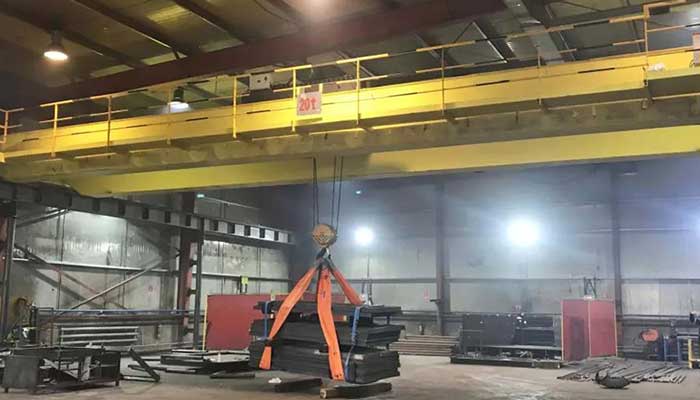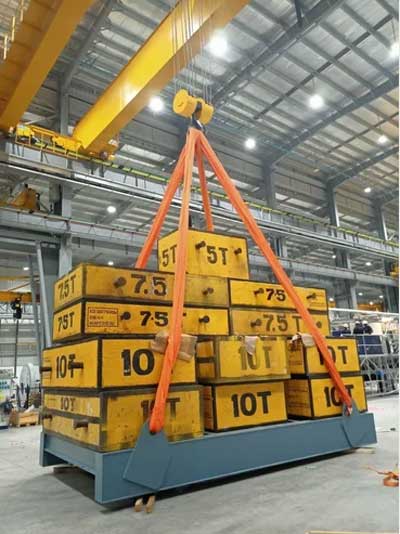EOT Overhead Crane Load Testing You Need To Know
EOT Overhead Crane Load Testing You Need To Know
Overhead cranes play a crucial role in modern industrial operations across various sectors. Given the potential risks associated with lifting operations, ensuring the safety and reliability of cranes is paramount. Conducting load tests is essential to assess the manufacturing quality and safety performance indicators of lifting machinery, such as the deformation of crane structures and the functionality of safety devices. This detailed guide outlines the step-by-step process and methods for conducting load tests on overhead cranes, covering preparatory tasks, no-load testing, rated load testing, static load testing, and dynamic load testing.
20 ton overhead crane load testing
Load Test Requirements for Overhead Cranes
Environmental Conditions at the Test Site:
To ensure the accuracy and dependability of the test results, the test site must meet specific criteria:
- The ground at the test site should be stable and level.
- The ambient temperature range should be maintained between -3℃ and +36℃.
- In outdoor environments, the ground-level wind speed must not exceed 8.3 m/s.
Specifications for Test Loads:
The test load for crane testing can be a single unit or a combination of various components based on different testing requirements. It may include solid steel blocks, concrete blocks, or containers filled with water or sand to simulate different load scenarios.
Methods for Determining Test Load Mass:
There are two primary methods for determining the mass of the test load:
- Direct method: This involves directly weighing the test block to determine its mass accurately.
- Combination method: This method utilizes a series of weights to achieve the required load weight through a rational combination of different weights.
It is crucial to ensure that the margin of error for the test load does not exceed 1% to maintain the accuracy and reliability of the testing process. This ensures that the test load accurately reflects the intended load conditions for assessing the crane's performance and safety features.
Preparatory Steps Before Testing:
1. Begin by meticulously inspecting the crane and trolley tracks, ensuring that they are completely free of any debris, including dust, dirt, and foreign objects that could compromise the smooth operation of the crane during the load test. Clearing the tracks also involves checking for any signs of wear or damage that may affect the crane's performance.
2. Prior to commencing the load test, meticulously remove all non-essential equipment, tools, and materials from the designated test site to create a clutter-free and safe working environment. This includes relocating any unnecessary items that could potentially obstruct the testing process or pose safety hazards to personnel involved.
3. Establish a clearly demarcated restricted area around the test site to control access and prevent unauthorized personnel from entering the testing zone. Implementing visible barriers, warning signs, and access control measures helps ensure the safety and security of the testing area, minimizing the risk of accidents or interference during the critical testing procedures.
4. Thoroughly inspect and tighten all connection bolts and rail compression bolts on the crane structure to guarantee their stability and integrity under load conditions. Any loose or damaged bolts should be promptly replaced or secured to prevent structural failure or accidents during the load test.
5. Verify the appropriateness and condition of all lifting appliances, slings, and rigging equipment intended for use during the load test. Ensure that these components are in good working order, free from defects or wear, and capable of safely supporting the anticipated test loads without compromising the integrity of the crane or posing risks to personnel.
6. Assemble a comprehensive array of essential equipment required for conducting a successful load test, including heavy-duty lifting baskets, communication devices for seamless coordination among team members, precise measuring tools for accurate load assessments, and sophisticated safety monitoring systems to track performance metrics and ensure operational safety throughout the testing process.
By meticulously following these detailed preparatory steps, you can optimize the readiness, safety, and efficiency of the EOT crane load testing procedure, setting the stage for a thorough and successful evaluation of crane performance and safety compliance.

double girder overhead crane load testing
EOT Crane Load Test Procedures:
The EOT crane load test comprises several stages, including no-load testing, rated load testing, static load testing, and dynamic load testing. The sequence of these tests is vital: begin with the no-load test, followed by the rated load test, static load test, and conclude with the dynamic load test. Each test must meet set criteria before proceeding to the next stage. Conducting a thorough visual inspection of the crane prior to testing is essential to ensure smooth operations.
Visual Inspection: The visual inspection covers various essential components of the crane, such as mechanisms, electrical systems, safety devices, structural elements, guards, hooks, wire ropes, and pulley blocks. No disassembly is required for this inspection, but access points for routine maintenance should be opened for assessment.
No-load Test:
The no-load test assesses the operation and lifting mechanisms of the crane and trolley. Key steps include measuring insulation resistance, checking system operations, inspecting safety devices, and ensuring smooth functionality of all mechanisms.
Rated Load Test:
This test evaluates functional indicators by loading the main hoisting mechanism with 1.0 times the rated load. Specific checks include speed measurement, braking distance assessment, and performance verification for different crane types.
Static Load Test:
The static load test determines the crane's bearing capacity and structural integrity. By gradually increasing loads and assessing various performance indicators, any deformations or damages affecting safety are identified.
Dynamic Load Test:
The dynamic load test verifies mechanism functionality and brake performance under dynamic conditions. Components are tested individually and collectively to ensure proper operation within specified parameters.
By following these comprehensive procedures for EOT crane load testing, you can assess product quality, enhance safety measures, and minimize potential risks associated with crane operations. If you have any need or requirements, please feel free to let us know.




